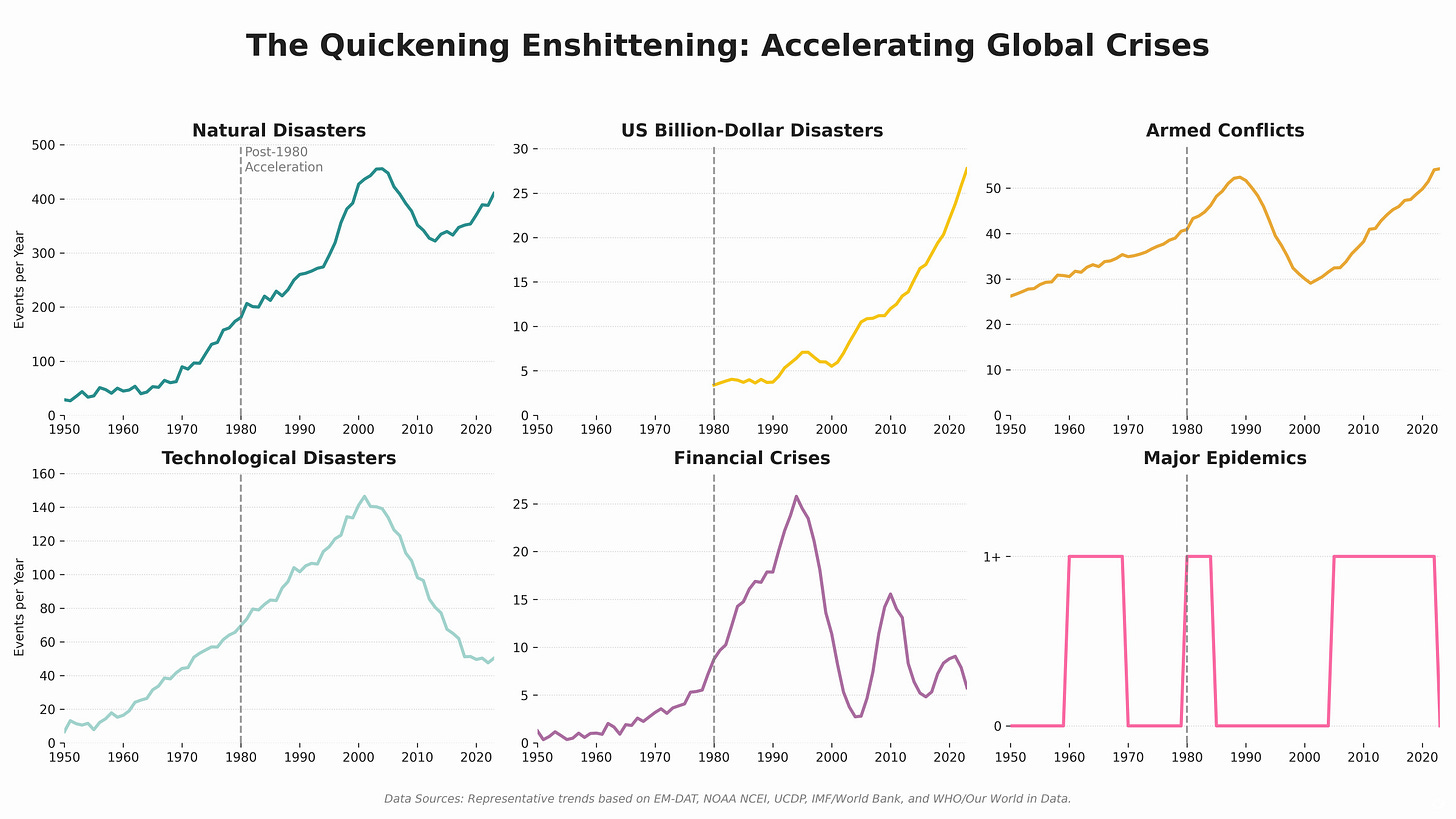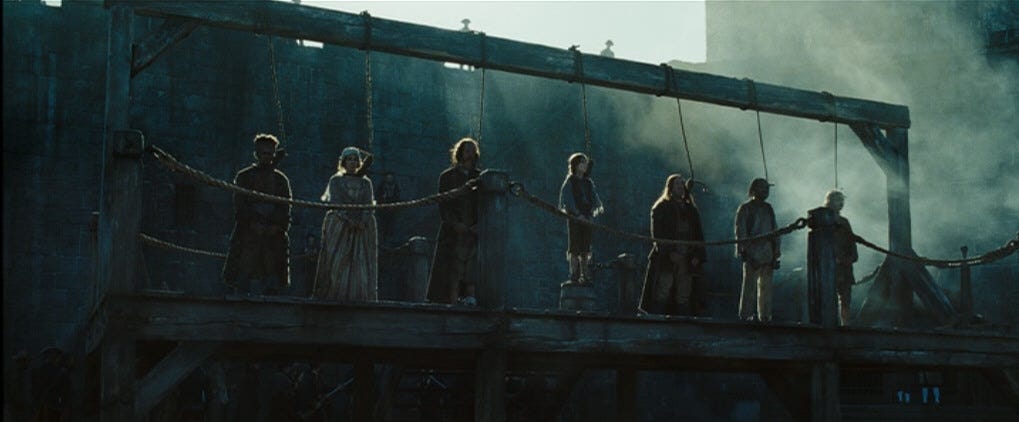Why I'm Not a Welfare Queen: Part 3
You are here now: The quickening enshittening at 89 seconds to midnight
Welcome to The Welfare Queen Series
This is Part 3 of a three-part series.
I recommend reading Parts 1 and 2 first, but choose your own adventure.
Our Final Act
Welcome to the final act of our trilogy.
We left off our story at the part where we realized we’ve only got 89 seconds to avoid accelerating into a shit storm — if only we understand where we’ve arrived.
Where we’ve arrived is a wild, wild time and place that reads more like dystopian fiction than consensus reality as we thought we knew it: authoritarianism is rising, the international order is ‘unraveling’, synthetic life is being birthed, and G7 leaders are preparing for war, while their citizens anxiously doomscroll predictions of a white collar bloodbath.
This is the quickening enshittening, the ‘fast part of collapse’, and we need to map an escape route before the stampede to the fire exits begins.
It is that map that we will draw today to bring our series to a close.
And don’t forget — I promised you it wouldn’t be all bad even if we must acknowledge how bad it really is, first.

A Message For Those Ready to Hear It
I started this series — and my re-emergence on Substack — by transparently acknowledging that I experienced a cannabis-induced episode of mixed mania at the end of 2024.
Mixed means there were psychotic elements, and psychotic, while a shitty word, basically means loss of connection to consensus reality.
I told you this because many of you (or at least those who followed me during Substack 1.0) watched it happen in real time. I shared this because many of you witnessed it. I felt I couldn't return without acknowledging what happened and where I am in my recovery.
During my ‘reality vacation’ I felt an urgent need to explain that we live in a collapsing society, unlike any crisis before.
I frequently repeated that:
collapse happens first imperceptibly slowly, and then suddenly very fast, everywhere, all at once. We are living in the fast part now.
I’m thrilled to have a chance to revisit this from firmer ground.
I no longer feel obsessive about making sure everyone knows this is happening. Those ready to engage will find me. I am not responsible—nor capable—of preventing what is already occurring.
But for those who are ready though, those of us who can feel the liminality in our bones, I’m back. I’m here. I’m re-integrated, sober, and properly medicated.
And, I think, so far, doing a much better job of sharing what I can see and what I think it’s all adding up to.
I also see that I am very much not alone; 'collapse' appears to be its own genre now, the writing perhaps fluorescent on the wall for those willing to look.
Video Killed The Radio Star
I also told you then that I’m someone who makes maps. This is, after all, what a human geographer does. Human geography is the study of the systems that govern our lives. It is both my autistic special interest and my intellectual lineage.
Not so useless after all, that Arts degree.
Yet, conceptual maps of invisible phenomena like culture and economies — and the critical analysis that creates them— are typically inaccessible af. Our ideas rarely ‘slither out of the ivory tower’ as Milton’s did because academia, like our other legacy systems, is a rigid, self-preserving, monolithic entity designed to gatekeep knowledge, specifically the only “credible” form of knowledge it acknowledges, to the erasure of the many ways of knowing that actually exist.
Or at least that was true until the internet came online circa ~1990.
It cracked academia’s vice grip on knowledge and truth, allowing people like me to smuggle ideas into the broader world, peer review and credentials be damned. We’ve quickly taken for granted that anyone can now theorize at will, to audiences bigger than most academics could ever hope to enjoy, 24/7/365, from bed in their pajamas.
In this information environment, intellectual speak only serves to alienate. Successful online influencers and culturemakers are those who can communicate their ideas in universal language. We remade oral tradition at scale and gatekeepers with their $10 words are very much not welcome.
This evolution of technology and popular culture has our legacy systems — the very systems theoretically supposed to enable our thriving — functioning more like a noose around our necks. They are — by design, as we covered in Part 2 — literally strangling the life out of a majority of us.
Look no further than:
the public service experiencing a 188% increase1 in mental health-related long-term disability claims since 2018.
The 60% of us with expenses that exceed our incomes, accumulating debt just for the privilege of being alive.
The 70% of us that are projected to have cancer by 2050 — but only in the Global North. Tellingly, cancer rates in the Global South are 3X - 4X lower, leaving us with few conclusions than the obvious: dominant culture and economies are correlated with higher incidence of lethal diseases, full stop.
It turns out, poverty isn’t the only thing that is state-sponsored.
The data does not lie, even if we want to lie to ourselves.
This is not normal.
This is not ok.
Not even a little bit, and it’s been this way Millennials entire lives. We are Homo Economicus’ precarious progeny, the first of us said to have arrived in 1980. We are the Enshittocene’s first human inhabitants.
We are credited with killing everything from marriage to cereal to chain restaurants, but my friends — that is some grade A manipulation, blame shifting, and narcissistic abuse.
We were birthed into collapse, we try to say it’s happening, we get told it’s not…but also that we caused it?
Wait, whaaaaaaat?
Excuse me?
Someone make it make sense.
The dissonance is deafening.
The kids are not alright.
The Big Short might be my favourite movie. This scene sums up what it’s like to be a millennial.
Capitalism *is* ending, just as Charlie Geller tries to tell his mom in this scene.
We do not need more xanax and zoloft.
We need you to listen.
Homo Economicus, The Corporate Narcissist, and his Alignment Problem
Speaking of narcissistic abuse, during my reality vacation, I introduced Corporate Narcissism to describe functioning in organizations and systems that break you, blame you, and then smile politely while doing it. Per their last email.
All our legacy systems operate like this. Reagan and his allies installed narcissism at scale when they embedded 'Homo Economicus' into our cultural root directory, optimizing for individual gain — more accurately, gain for corporations.
When birthing synthetic life that learns exponentially, becoming PhD-smart in two years (relative to the ~30 years humans need to do the same), this calibration becomes a very, very big problem.
The AI ethicists call this the Alignment Problem: giving a genie your wish, but forgetting to specify it should not murder the village while granting it.
It’s not the code that tells AI to ‘murder the village’; it's command. It’s us.
More abstractly, our 'command' relative to AI is the cultural root directory.
People are freaking out about the potentially murderous synthetic geniuses we've unleashed, but it's only doing what we programmed it to do.
Its cultural operating system is ours. We installed it. We trained it on our data: a steady diet of gaslighting, manipulation, and quarterly reports.
We write headlines like "white collar bloodbath" — not AI. At least, not yet.
As
puts it, we are AI’s parents. It is our child(ren) raised in our image, by our definitions of success.Profit over people.
“Scale” over sanity.
Hustle over humanity.
It is just doing what we asked — moving fast and breaking things.
I’m not sure if you’ve spent much time around toddlers who are moving fast and breaking things, but that shit is chaotic as fuck.
Compounding chaos is not what we need when it’s 89 seconds to midnight and G7 leaders are holding pressers with militaries in frame, announcing accelerated defence spending in 'the closest thing to a call to arms from a prime minister since September 1939 — the start of World War II.'
Let’s all take three deep breaths together before I carry on in today’s map making exercise.

Learning To Make Maps
The class that made me want to be a human geographer was called World Problems in Geographic Perspective, taught by Allison Shaw. I was obsessed from her opening hook, surveying the entire lecture hall:
‘Raise your hand if you think there will be a war over oil in your lifetime.’
It was 2007. The US had been in Afghanistan for six years, Iraq for four.
Easy. A gimme.
All the hands shoot up.
‘Raise your hand if you think there’ll be a war over water in your lifetime.’
Nervous glances.
A few hands go up.
Mine goes up because I assume it’s rhetorical, not because I’m actually confident in the answer.
One of our core readings that semester was Jared Diamond’s book, Collapse: How Societies Choose to Fail or Succeed.
He’d developed a 5-point framework — a map — of civilizational collapse. Even if you haven’t seen Jared’s map, you do know it, because we’re living it.
Collapse, he taught us, builds slowly and somewhat imperceptibly over generations. After uncontrolable factors like a changing climate, the cracks of collapse begin when we:
take more than our share;
pick fights with our neighbours;
alienate our trading partners and;
take one too many shits in our own backyard.
Humans are bad at seeing slow-moving collective phenomena over generational time, so these issues go unnoticed — at first. Eventually, cracks become chasms. A convergence of crises, a quickening, signals the collapse period has started — that it is 89 seconds to midnight
These decaying systems and precarious conditions should be obvious to everyone, but especially leadership and elites. It’s as obvious as a stampeding herd of drunk elephants suddenly arriving in the room.
Except Emperors without clothes are incapable of acknowledging drunk elephants.
Arguably they really should be paying attention to the blaring signals of hastening societal demise.
Instead they’re busy shorting housing markets, launching rockets, counting their stacks over brandy and cigars.
Occasionally they might commission a study or two on elephant behaviour to quiet the masses — only to bury the findings in committee meetings while their PR teams stand at the podium saying,
“elephant?
What elephant?
I don’t see any elephants.
You must be mistaken.”
What transcript?
To take my tongue out of my cheek — since this one’s pretty important to understand — Diamond said collapse happens when a series of stressors and environmental conditions converge and the humans in charge fail to notice, and/or delay and/or refuse to adequately respond.
And the converging conditions that signal collapse periods will feel uncomfortably familiar:
Environmental damage
Climate Change
Emergence of hostile neighbours
Loss of friendly trading partners
Ineffective response to systemic problems
I don’t think you need a human geography degree to see what I mean now.
Perhaps it is getting more obvious that we are, indeed, living in the ‘fast part of collapse.’

WTF is Punctuated Equilibrium?
Diamond’s map wasn’t the only one I picked up that semester.
My Biogeography class was a struggle. I found the content boring, and skipped just often enough to still do well. One lecture I did attend — and found myself engrossed in — was about punctuated equilibrium.
Punctuated equilibrium is the evolutionary version of "everything’s chill until it really, really isn’t."
It’s close to the epochal version of Diamond’s collapse pattern.
Long periods of stasis, then boom—meteor, volcano, massive species remix.
RIP Littlefoot.
Hello, Ancestors.
These collapse-and-proliferation periods delineate epochal shifts, like the Pleistocene, or, our theorized current epoch, the Anthropocene. Epochs, the grandest scale of planetary history, also emerge through this pattern of transformation—the old making way for the new.
And what I’m laying groundwork to tell you is that the reason everything feels so fucked up right now isn’t just because we’re at the precipice of war. It is because we are living through an epochal change. Our cosmology, ontology, culture, organizing structures—all of it is being remade. Assuming we survive long enough to remake it.
The Anthropocene gave way to the Enshittocene, and the Enshittocene is about to give birth to something new, ready or not, like it or not.
The Anthropocene was our (brief) period of equilibrium. The Enshittocene is our herd of drunk elephants arriving.
So far, the study validating their existence awaits approval.
According to Diamond's model, we are about to go the way of Littlefoot and the dodo bird.
But I might be skipping ahead. Let’s pause to make sure it all makes sense.
We’ll get to how collapse isn’t always bad, and what we need to do with our 89 seconds, before we’re done.
The Repeating Pattern of Transformational Crisis
Learning these two frameworks so close together allowed my brain to do what it does: drag and drop concepts, look at them from all angles, and ask, ‘Hey, do these go together?’
This intellectual remixing birthed my obsession with transformation, and transformation is the third and most important map we need today.
Punctuated equilibrium and Diamond’s collapse pattern are the same pattern playing out at different scales. Punctuated equilibrium zooms out to evolution and epochs (hundreds of thousands of years); Diamond’s pattern applies to human organization (hundreds, occasionally thousands, of years).
Boiled down, transformation patterns go like this:
Stability > Disruption > New Normal or Old Normal.
That last distinction is critical.
Not all disruptions lead to transformation. Transformation means something fundamentally different emerged. Change, by contrast, is not a synonym; it’s part of the process. It’s incremental progression, a continuation of the Old Normal despite upheaval.
We saw this after the 2008 financial crisis, or even COVID. Both were massive disruptions that could have led to a new form, a collective response, but instead we snapped back to the Old Normal. Historically, societies that collapsed chose the Old Normal.
So far, so are we.
This map helps us see transformation patterns everywhere.
They’re everywhere because organic life patterns repeat across all scales: cells, individuals, collectives, systems. Systems scientists call this fractal patterns, self-similarity, and scale invariance.
This means once you have the map, you can apply it anywhere. And this is the map Friedman had. This is what he was watching for and what he meant by,
"Only a crisis—actual or perceived—produces real change. When that crisis occurs, the actions that are taken depend on the ideas that are lying around"
Joseph Schumpeter, one of my favorite economists, used this map for economies, calling his version, Creative Destruction. I love this version because it’s honest and accurate, assuming creation emerges from destruction.
The phoenix needs ashes to rise.
Many other everyday experiences you’re familiar with follow this pattern. Growth spurts is a favourite example. You put your toddler to bed speaking in messy fragments. They’re delivering speeches at will the next morning.
And then there’s the most universal of all, creating life. Birthing goes first slowly—nine months of gestation—and then suddenly, very quickly, all at once.
Birthing is a very accurate, literal description of what we are living through, at multiple scales simultaneously: Economy. Culture. Epoch.
This is what it feels and looks like to live during a growth spurt, to witness the birth of new epochs and synthetic life.
We are in collective, evolutionary labor, the fast part where contractions quicken, where the nurse tells mom to push.
And the part where a lot can go wrong, even fatally so.
Psychedelics, AI, and the Plastic Moment
That was pretty heady and conceptual, so let’s bring it back to the personal.
My ‘reality vacations’ followed the transformation pattern. I looked okay until a sudden escalation when I really wasn’t. The lead-up — what psychiatrists call a ‘prodrome’ — was when incremental changes snowballed into crisis. Even though it seemed sudden and intense, it had been building for months.
I didn’t hear the whispers, so we all had to listen to the screams.
In the wake of profound personal disruption, there is a period of heightened neuroplasticity, a vacuum of possibility.
This is where meaningful integration, a reconstitution of self, can occur.
This is the moment when agency and choice matter.
Psychedelics disrupt your status quo profoundly enough to give you a chance to rearrange the pieces before they lock back into the old pattern. Psychedelics defrag, but it’s up to you to integrate them, to determine if there will be a New or Old Normal.
And this is where the parallel to our collective moment becomes starkly clear.
Psychedelics (including cannabis) are to the individual what AI is to the collective: an accelerant, a magnifier, the stressor that might break the camel’s back.
The internet coming online was like all humanity taking a dose of ayahuasca.
AI arriving is like going back to the shaman for a second and third cup in the same ceremony.
We are shaking the snow globe in the most fundamental ways. What we think we know about our place in the universe, how we organize, how cognition works—all of it is being remade. You just have to zoom out really, really far to see it.
Your daily life might feel mundane, consumed with survival, stretched by the status quo. But that eerie, creeping, undeniable sense you can feel but struggle to name, that you keep trying to ignore but can’t, is this much bigger transformation unfolding.
This plasticity, this vacuum after disruption, is the crucial moment. Friedman and his allies used their ‘plastic period’ — the crises of the 1970s and early 80s — to force a transformation. Their version of post-disruption integration was to reconfigure the relationship between the state, labor, and the private sector; to reform society to Homo Economicus’ advantage.
Since then, we’ve filled each post-crisis vacuum with more of the same. We’ve repeatedly chosen the known, the safe, the comfort of Old Normals.
And here is where we borrow from psychedelic movements again with the ‘Too Much Too Fast’ definition of Big T Trauma.
Except it's not just a concept that applies to human bodies. Like other ‘self-similar’ patterns, it is more universal.
When a system—individual or collective—is at max crisis capacity, adding accelerants or forcing radical change without preparation nearly guarantees Big T Trauma.
Responsible psychedelic practitioners turn away those for whom disruption would be ‘Too Much Too Fast’ due to chaos risk. They recommend reducing ‘allostatic load’ first, the fancy way of saying, systemic max capacity.
Try it a different way: there’s a critical difference between a china tea cup falling off the counter and breaking into 3 or 4 pieces you can lovingly restore—same vessel, new, more integrated form—versus smashing it with a sledgehammer into dust.
Dust cannot be glued back together.
This is the difference between a controlled burn and a raging wildfire. After a controlled burn, the phoenix can still rise from the ashes. A raging wildfire might take the entirety of the phoenix with it.
The shit storm G7 emperors without clothes, particularly America, seem to be accelerating us toward — their refusal to admit elephants are in the room — is the Too Much Too Fast sledgehammer version of transformation.
It is the third cup of ayahuasca in a ceremony we shouldn’t have been in in the first place.
The Choice: Sledgehammer or Trust Fall? Old or New Normals?
On June 9, Mark Carney stepped up to a podium to tell Canadians we are confronting a “hinge” moment, an “unraveling of the international order,” and that his government will rapidly accelerate defense spending, shifting from emphasizing Canadian values to Canadian strength.
It bears repeating, as
described in a few days ago, that this was “the closest thing to a call to arms from a prime minister since September 1939 — the start of World War II.”And yet, questions of how to pay for this, of “ameliorating the impact of tax hikes or the undermining of social services,” are false questions if we understand where we are.
If we can prepare for war, why can we not prepare for transformation?
Why can we not admit it is 89 seconds to midnight and suspend the bullshit jobs AI is slaughtering its way through, offer basic dignity and financial security, and turn our attention to something other than accelerating our destruction?
Complex adaptive systems can only be forced into the same pattern for so long before they self-correct, usually through uncontrolled destruction.
When responsive to signals that a system is no longer fit for purpose, you gain choice and agency in the ‘destructive’ period. You will go through it all the same, much like birth requires labor, but you can remain relatively whole and safe. You can choose the epidural at the hospital with the best midwives.
However, repeatedly ignoring that new is trying to emerge, that a birth is occurring, that elephants are in the room, exponentially increases the risk of lethal disruption — that mom and baby may not survive the labor.
Resisting emergent, necessary, adaptive transformation at the collective level is self-sabotage at the individual level.
We cling to familiar, even painful, patterns because the unknown feels more terrifying. But in the grand, cyclical dance of complex adaptive systems, such resistance isn’t merely futile; it invites a more violent, uncontrolled, and potentially catastrophic recalibration. We’ve seen this in our own lives, and we are seeing it unfold on the global stage right now.
My point is we will go through this ready or not, but we have a brief moment, 89 seconds specifically, to put down the sledgehammer and hope the teacup only falls from the countertop.
We know it will break either way, we know it won’t be pretty, but at least we have a hope in hell of reconstituting it—ourselves and our societies in this metaphor—in a more durable, responsive, resilient way.
We must face that this isn’t a time to tinker.
We need to acknowledge that the institutions built to sustain the Industrial Revolution aren’t just no longer fit for purpose, but are — as we previously called them — the noose around our necks.
In doing so, we might just keep the chair under our feet long enough to orchestrate a daring escape from the gallows.
To do that, however, we first have to admit we’re encircled by elephants, precariously perched atop a chair on the gallows to begin with.
And we must have an escape route mapped.
We must have a New Normal north star to guide us.
Writing a New Myth: New Normal North Stars and The Polyculture Future
So, if Neoliberalism was the ‘Before’, what could be the ‘After,’ the New North Star?
One way I see it: if centralized power and monoculture define our ‘Before,’ then distributed, decentralized power and polyculture will be the New Normal ‘After.’
This cannot be at the scale of Nation States. Nation States — and the institutions they ruthlessly protect despite so much evidence they’re the problem — are and will inevitably break down, be it by sledgehammer or fall from the countertop.
And when they do, and if we’re still here when the hopefully-not-dust settles, community, niche, and micro will be the new scales that matter.
And, because of this — and I must just say this very plainly — the leadership we need now is Indigenous.
Indigenous cultures and perspectives, particularly on the West Coast of Turtle Island as I know them, are the templates we need, the leadership we must humbly seek partnership with.
There we find living, thriving examples of how society can be configured as a responsive web of self-governing, self-sustaining, cooperative communities of communities.
Plus, I’ve seen some of the maps, in particular Carol Anne Hilton’s map called Indigenomics.
It’s persuasive as fuck.
I’d sign that social contract in a heartbeat.
I’d bet the 50% of people under 40 who have an unfavourable view of capitalism, and the ~33% who actively want something different would be want to take a good look at it too.
And here we pause for a caution: we have to be wary false framings like Capitalism OR Socialism. That framing is monoculture manipulation, as we’re very well establishing here.
In polyculture, we learn to say and.
We remix.
We integrate.
But we don’t force false binary choices between two failed systems and lie about no alternatives existing.

I’ll add some nuance here to my perhaps too-declarative framing and say that Indigenomics won’t be the only alternative economic model we need. There will be — there already are — other examples of effective, resilient distributed economics and leadership elsewhere. Indigenomics is just the best example I know to point to. The next best one I know is the entirety of the internet, pre-shittification.
And if millennials and the internet killed anything, it was the The Iron Lady’s not-so-iron-clad lie that There Is No Alternative to the Great Enshittening.
Ding dong, the witch named TINA is dead — along with the monoculture that birthed her.
All that’s left is to give her the funeral she may not deserve. And it begs the consideration that, perhaps, our collective inaction in the face of collapse isn't entirely intentional, but rather an instinctual paralysis — a form of societal grief and denial that precedes the unprecedented.
In a polyculture future, there won't just be one right way; there will be many, born of, and responsive to, the communities and places they're emergent from.
Think of mushrooms and mycelium: mycelium is a universal, unifying network stretching globally, but mushrooms fruit in forms specific to their environment — 14,000 different forms and counting at present.
Our future needs to work like that.
It actually already works like that, at least in some places. Indigenomics already exists and is poised to take off, some calling it the next engine of Canada’s economy.
Everywhere you see old norms breaking down — gender, sexuality, relationship models — is where you’ll find clues about where we are going, if only we survive long enough to get there.
Our complex system is trying to adapt.
A new normal is trying to emerge — if only we let it.
I call the collection of these new possible normals, relational economics, but we’ll come back to that in future pieces.
For our purposes today, it is important pause and remember that history does not unfold linearly. We didn’t have feudalism on Tuesday and capitalism on Wednesday. When Adam Smith wrote The Wealth of Nations in 1776, he told us what Capitalism was by observing the world as it existed, as it was emerging around him. A messy mix of new emerging from old, breakdown and breakthrough stirred up by invisible hands and entrepreneurial spirits, a remix of feudalism and mercantilism, a third way that would eventually come to dominate — in no small part thanks to the ideas he left laying around.
And so this is also what I mean when I borrow from William Gibson and say the future is already here just not evenly distributed.
Collapse and better possible futures are happening simultaneously.
This is how emergence in complex systems works.
It is also why I use the phrase Now/Future: Breakdown and breakthrough, co-existing, in different places at the same time.
And that which is not already here, the possibilities we need to allow to fruit in the ashes that are starting to collect around us, have already been professed. There are at least 240,133 Ideas Worth Spreading laying around at present. And that’s only if we count the ones the internet let spring forth from the TED stage.
Which is all to say, we are not short on maps to ‘The New Good Life’; not short on ideas for generative futures worth living in.
Not even at all.
Ideas are the least of our problems.
What we are short on is political will and leadership willing to recognize that the (neuro)plastic period is upon us, that we must make the politically impossible, the politically inevitable.
Many new inevitables, in fact.
For many new normals.
***
This series is dedicated to my dear friend Randy Gallowan, one of my all time favourite thinking partners, a theorist of the Enshittocene before we knew what it was; the one who taught me the difference between ontology and epistemology, in-between cry-laughing over College Humour and Jon Lajoie videos; the one who loved a good info-dumping session, often in his underwear, in the kitchen at The Blue House; a rare Zebra, definitely not an everyday normal guy; a truly complex and brilliant character who deserved a future worth living in.
I’ll miss you for the rest of my life, Randy.
***
Sneak Peak
Gemini and I collaborated to create a simple work-in-progress website to host my foresight work on the emerging relational economy. It’s the foundation for New North Stars and ‘futures worth living in’.
You’re invited to check it out — you can even chat with my chatbot while you’re there!
While the public sector as a whole has documented a notable rise in mental health-related LTD claims, the 188% stat is from a consulting project I completed a few years ago; for privacy reasons further details cannot be disclosed.
***
If this piece lit up your brain and heart at the same time, sharing, liking, commenting or subscribing is Creator Speak for “fuck i love you, too”.
And let’s be honest this is still capitalism and this economy is shit (again) so I don’t use paywalls. If you’re in a good position and excited to
make a one-time or monthly contribution,
I’d be super grateful.
I’ll still fucking love you either way.
***













"Smith argues that morality is not driven by some innate moral sense, as was claimed by his old teacher Francis Hutchison, but by humanity’s natural sociability – the need for approval from our peers. We behave to one another in ways that allow us to get along together, but this does not stem from a rational calculation to gain personal advantage. Instead, our responses are driven by our emotions, the principal of which is our capacity for empathy."
https://www.panmurehouse.org/adam-smith/works/the-theory-of-moral-sentiments/
Finishing this series felt strange. I didn't come to substack expecting to find alignment. I just figured it was another "social media" site- somewhere to repost my blog entries like I'm wont to do in other places too. But this place is different. It is quiet in its impact. The gaps of silence are big because an alert: a like, a comment, a repost are like deafening noises: because you know that in same way your thought really resonated with another human at a much deeper level than click-bait or shock engagement. That really means something to me and draws me back to Substack.
When I say alignment, maybe I mean resonance. Reading your personal struggles (thank you for being so candid) but also your hopeful cynicism about Capitalism (I can detect hope a mile away, don't tell me it's not there!) I can say, I feel it too. The last week or so we have been on a parallel journey and even though I don't want to post it... I have to say part 3 really felt like a setup for what I posted today.
My version of hope.
https://chevan.substack.com/p/introducing-opportunity-economics?r=8ae8z